At Seoul Garden Club Live Flower Arrangement Exhibition
The Seoul Garden Club hosted a Live Flower Arrangement Show at the Ramian Gallery in Seoul on May 6, 2015 with the attendance of Founding Chairperson Mrs. Im Wha-kong of the Club, 2015 President Mrs. Helen Paterson (wife of the ambassador of Australia), incumbent Chairperson Lee Jong-sook and some 50 Korean and foreign dignitaries, mostly the wives of the ambassadors in Seoul and media representatives.
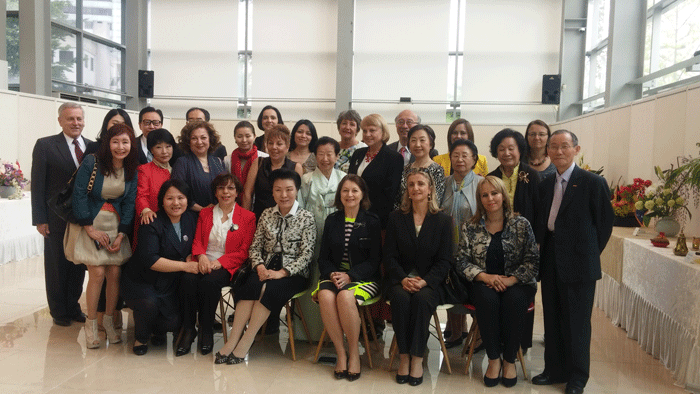
Among the distinguished guests present were Ambassadors William Paterson of Australia, Elisabeth Bertagnoli of Austria, Aingeal O’onoghue of Ireland, Bessho Koro of Japan, Krzysztof Majka of Poland and Omrie Michael Golley of Sierra Leone.
A total of 20 live flower works were on display created by Mrs. Im, Mrs. Lee, Mrs. Han Kwang-ho (widow of the late and the wives of the 17 ambassadors in Seoul.
There also were Honorary Consul Kim Young-il of Pakistan and Publisher-Chairman Lee Kyung-sik of The Korea Post.
Each work was created on a different theme and name and exhibited the distinctly different cultural features of each country represented?many of them introducing the colors of their National Flags and some accebted with unique artifacts of their country.
Speaking to the guests, President Paterson said, “Today’s Show will demonstrate the many and varied talents of the Ambassador’s wives’ floral displays, showcasing their countries’ cultural themes, colours and unique features. It promises to be a lovely exhibition of spring colour and uplifting elegance through flowers, whether simple or ornate.” (See excerpts from the speech toward the end of this Article.)

The participating wives of the ambassadors were, in alphabetical order, Mrs. Chafika Derragui (spouse of the Ambassador of Algeria), Helen M. Paterson (spouse of the Ambassador of Australia), Ja Hyun Choi-Bontemps (spouse of the Ambassador of Belgium), Nehal Selim (spouse of the Ambassador of Egypt), Monika Ascensio (spouse of the Ambassador of Guatemala), Maria Giovanna Fadiga Mercuri (spouse of the Ambassador of Italy (Residence), Avazeh Kasrai (spouse of the Ambassador of Iraq), Mariko Bessho (spouse of the Ambassador of Japan), Zhanna Baigaziyeva (spouse of the Ambassador of Kazakhstan), Mun-Adil Magsarjav (spouse of the Ambassador of Mongolia), Amal Lahlou (spouse of the Ambassador of Morocco), Sissel Kathrine Pindsle (spouse of the Ambassador of Norway), Marijana Lijovic (spouse of the Ambassador of Sierra Leone), Zofia Majka (spouse of the Ambassador of Poland), Madeleine Wick Reding (spouse of the Ambassador of Switzerland), Pinar Ockal (spouse of the Ambassador of Turkey) and Gulya Mammetalyyeva (spouse of the Ambassador of Turkmenistan).
Here are the names and descriptions of the floral works created by the wives of the ambassadors:
Australia by Mrs. Hellen Paterson (wife of the Ambassador of Australia and president of the Seoul Garden Club):
The name of the floral work is the 'Fragrant Spirit of Australia.' This arrangement included pale yellow carnations, yellow miniature hydrangeas, white lilies and pink wisteria. Australia's national colours are: green and gold. The fragrance comes from the lovely wisteria and the oriental touch was the Korean vase and the oriental structure of the arrangement achieved by the wooden stems of the wisteria. The focus of the arrangement was the simple white lily, fully-opened, and elegant in its glory. The wisteria and miniature hydrangeas come from the garden of the residence of the australian which is a lovely, old garden which has been well-tended over the last 40 years or so.
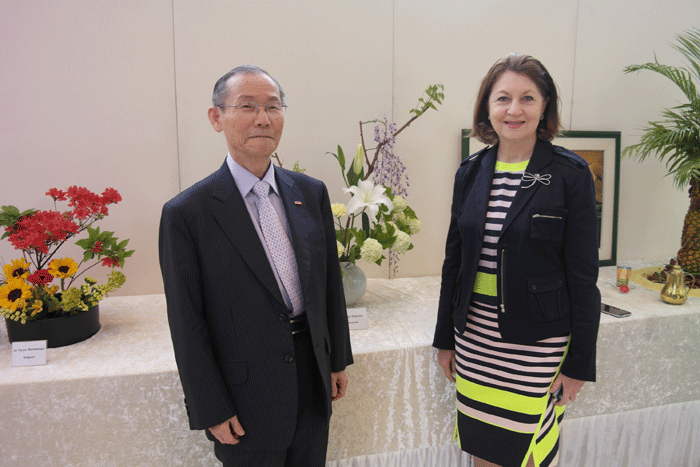
I learnt Ikebana (Sogetsu school) whilst posted with my husband in Japan, so I was so happy to continue the oriental art of flower arranging, specifically Korean, at the Garden Club of Seoul, under Mrs. Im Wha-kong's supervision.
I have always loved flowers and in Australia we have quite a big garden in our Canberra home with many varied flowers, shrubs and trees, including both native flora and those introduced from Europe. There is always plenty to pick in the garden and fill vases with for decoration. Even if we don't have flowers out, the shrubs, berries and coloured leaves are plentiful, including the lovely Australian native plants and wild flowers.
Egypt by Mrs. Nehal Selim (spouse of the Ambassador of Egypt):
The name of my flower arrangement is "The Spirit of Egypt". I went to the flower market with a certain idea in my mind, but when I saw the cotton flower, Ii changed my mind.
Since we are supposed to show something related to our country and since Egypt is famous with its unique Long Staple Cotton, so I thought of using the branch of cotton as a central piece in my flower arrangement, but it was not that easy.
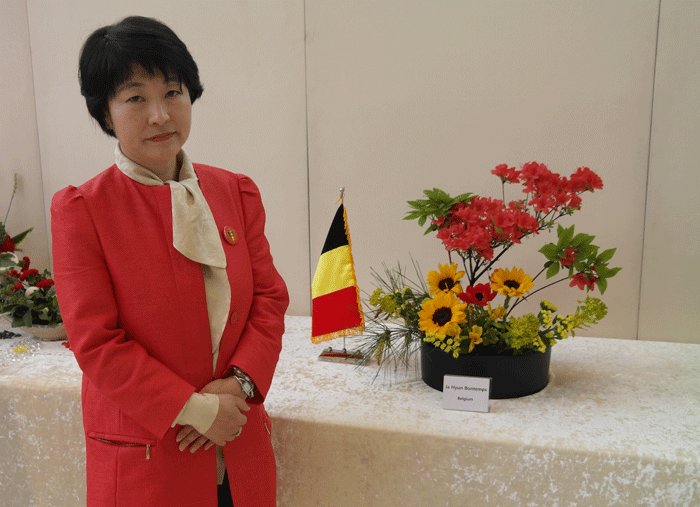
However, inspired by the colors of our national flag, I made the arrangement with red flowers, symbol of the struggle for reform and stability. The white flowers and green leaves symbolize peace and prosperity.I decorated my arrangement with some ancient Egyptian ornaments to bridge the great ancient civilization of Egypt with modern Egypt as reflected in the flag's colors.
That was simply my theme.
Italy by Mrs. Maria Giovanna Fadiga Mercuri (spouse of the Ambassador of Italy):It is linked to the International Expo Feeding the Planet, Energy for Life. It is composed by hydrangeas, anthuriums and zantedeschias, forming together the colors of the Italian flag, displayed in a design vase by Armani, one of the most known brand from Milan. Beneath there is a map of Milan, in the shape of a table mat, by another famous designer brand, Seletti. "Feeding the Planet, Energy for Life" is the core theme of Expo Milano 2015.
Expo Milano 2015 will provide an opportunity to reflect upon, and seek solutions to, the contradictions of our world.
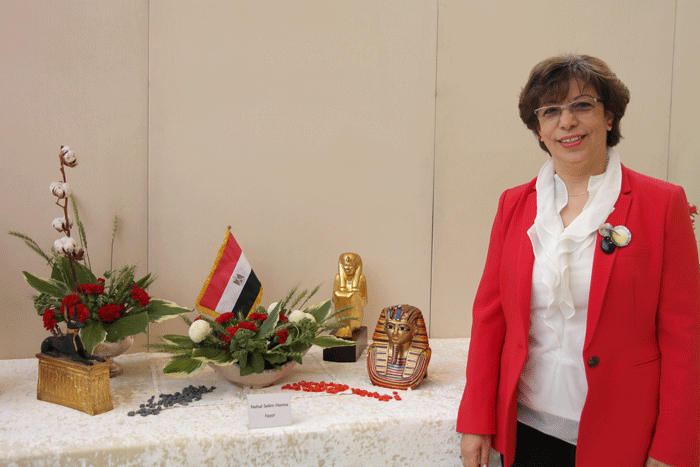
It has just opened in Milan last Friday, May the 1st and it will last until the end of October 2015. A key aspect of Expo Milano 2015 is the array of countries from all over the world that have agreed to interpret the theme: Feeding the Planet, Energy for Life. Food. For food is a vital part of daily life for everyone everywhere. It can bring together people of different cultures and religions, but also implies addressing many challenges. Every participating country has been charged with questioning and offering solutions to the major challenges related to the future of food, and each will provide those answers by drawing upon its own culture and traditions. The Expo Milano 2015 exhibition site has thus been transformed into a mosaic of countries committed to creating awareness of a theme that is of critical importance for future generations. Expo Milano 2015: 184 unique days of culture and science, innovation and tradition, sustainability and solidarity where visitors can find over one hundred national cuisines each with their own tastes, aromas, and colors.
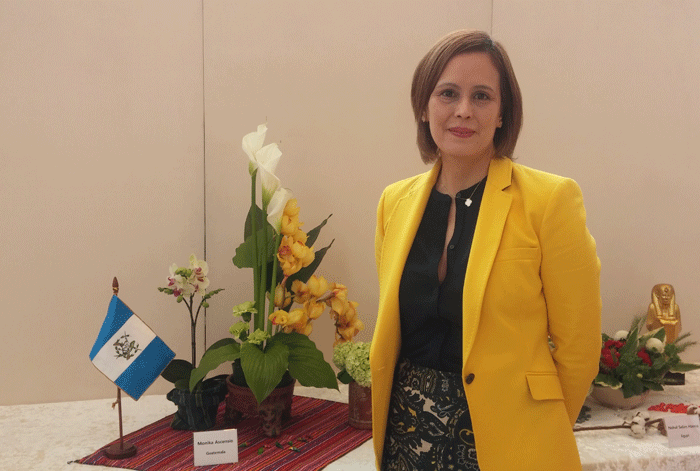
Japan by Mrs. Mariko Bessho (spouse of the Ambassador of Japan):
As in the last year, Mrs. Besshor presented her live flower arrangement work together with a famous poem of the Orient, this year that of a famed Chinese philosopher-scholar of the late Ming Dynasty named Hong Ja-seong (Hong Zicheng in Chinese and Ko Jisei in Japanese). The poem or a wise-saying is named Chaegeumdan (Caigentan in Chinese and Saikontan in Japanese). From Caigentan, Mrs. Besshor cited the following clause:
“The mountain looks fresh and beautiful after rain.
The sound of bell lings clearer in a quiet night.
Which means when you have a clear mind, life sounds more meaningful.”
However, one of Hong’s wise-sayings more widely known in Korea is: Jakdeuk chaegeun baeksa hago (Jiao de caigen, baishi ke zuo [嚼得菜根, 百事可做] which literally means “One who has chewed vegetable roots [for lack of anything better to eat] can accomplish anything." It also translates, figuratively: "One who has gone through hardships can do anything." (See further details on Chaegeundam at the end of this Article.)

Poland by Mrs. Zofia Majka (spouse of the Ambassador of Poland):
The name of the floral work is Flower Diplomacy. I am happy that Samsung Raemian Gallery and Garden Club are continuing a tradition of engaging diplomatic community in organizing ikebana exhibitions on annual basis, exhibiting compositions of different flower arrangements ,representing national colors of various countries. Ikebana is more than simple putting flowers - it is a creative expression. I thing that the whole event can be called a flower diplomacy. It is amazing how through different composition is possible to express a spirit of the country. Flower arrangements from different countries show different styles but all together make an exciting event bringing different countries and Korea together in artistic unison. That is why I call the even a flower diplomacy.
In my Polish flower presentation I used red and white colours. White colour in Polish tradition reflects high moral virtues, nobleness and red colour means honor, blood and sacrifice. Those two colors portray a difficult Polish history and straggle for regaining an independence and sovereignty of our state. In that sense history of Poland is quite similar to the Korean history. In my flower arrangements I used a lot of wild flowers which are in our garden to also express simplicity and beauty of nature.
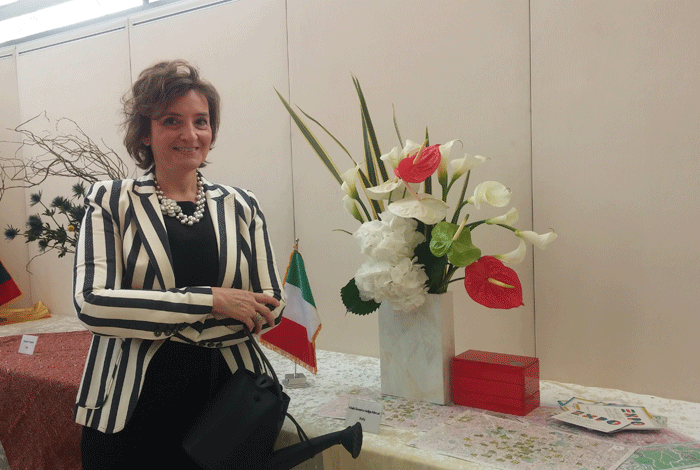
Sierra Leone by Mrs. Marijana Lijovic (wife of the ambassador of Sierra Leone):
I have decided to name my arrangement Sierra Leone ‘Harmony.’ I have been very keen to highlight in this presentation the beauty and connectivity of both flora and wood in Sierra Leone.
Sierra Leone is a country of lush vegetation, tropical flora and fauna of bright colours and life. In addition, our country is fortunate to have vast tropical woodlands, rich in colour and diversity. I wanted to portray a country at peace, full of beautiful and vibrant people, emerging from recent difficulties, with a determination to progress and prosper.
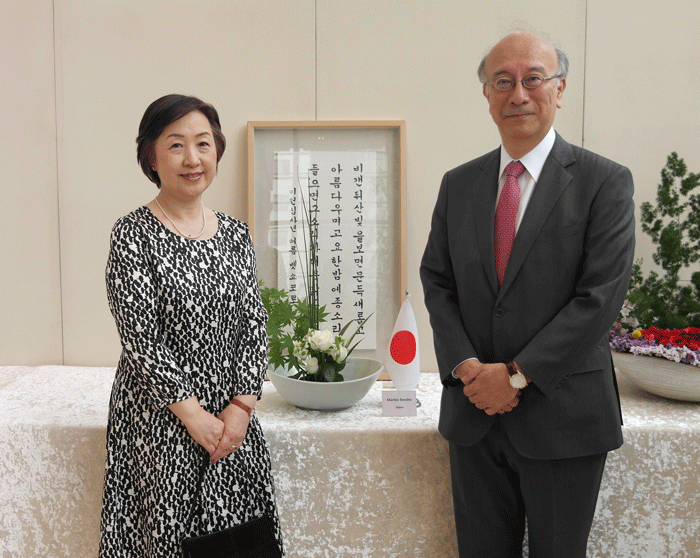
Switzerland by Mrs. Madeleine Wick Reding (wife of the ambassador of Switzerland:
The title is: Flowers from my May Garden. I chose four different flowers for the arrangement: peonies, vetches or also called sweet peas, a kind of small bush roses and spiraea. They all bloom in my garden back home in Berne in May. I like wandering through the garden and picking fresh flowers in season, especially early in the morning.
The four kinds represent the diversity of our small country with four main regions, each one with their own national language: German, French, Italian and Romanic. And…, I could name hundreds of plants which are indigenous to the Swiss Alps like Edelweiss, Alpenrose or Enzian.
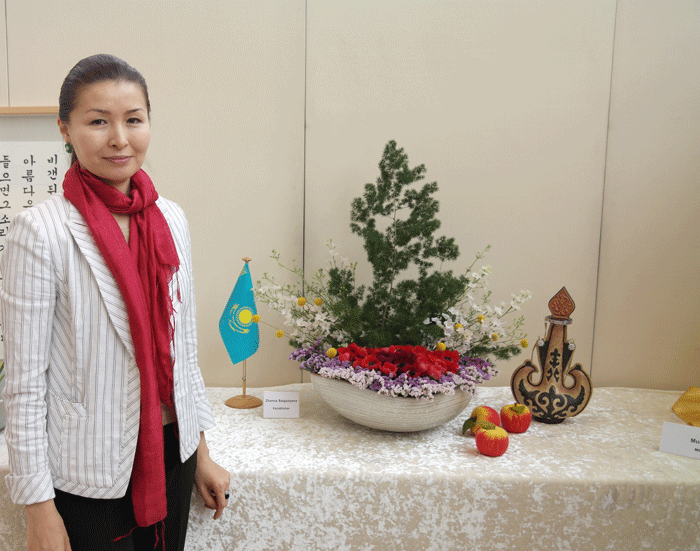
Turkey by Pinar Ockal (spouse of the Ambassador of Turkey):
This year while preparing the flower arrangements I have used one to one copies of vases and containers from Ancient Anatolian Civilizations, particularly from Hittite Civilization with motives that represent wealth, prosperity and fertility. Therefore, I choose the flowers for my this year's arrangement as sun flowers which are blooming in May on the Anatolian fields. As you know sun flowers follow the sun all day starting from sun rise until sunset. For Hittites on the other hand, sun the symbol of their art. All these, as well as Korean way of arranging flowers inspired me while preparing my humble arrangement. I did not name my work, but now that you are asking, we may call it "Anatolian Breeze ".
Excerpts from the speech of Mrs. Patterson, president of the Seoul Garden Club:
This Flower Show is in part the brainchild of our dear friend and long-serving patron, Mrs. Im Wha-Kong, who so tirelessly gives of her time, ideas and supervision each year and in encouraging and motivating us to do this Show. Her design of the magnificent centerpiece display on the round table is testament to her arrangement skills. We are very grateful to you Mrs Im for your hard work.
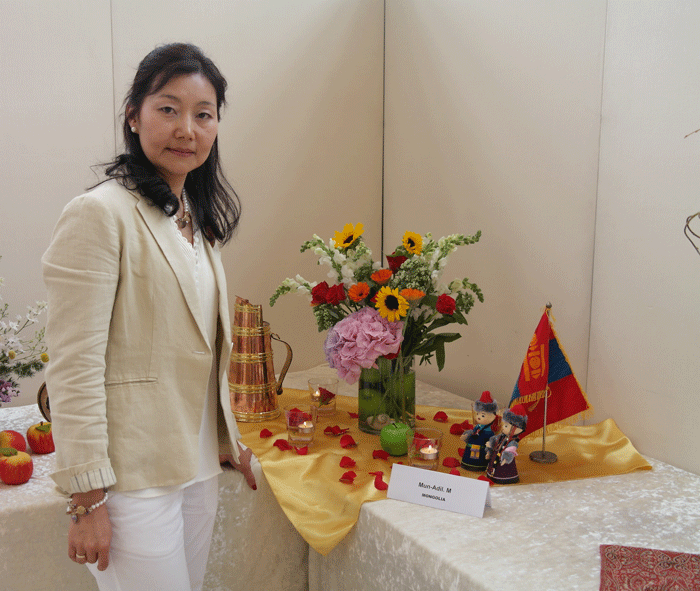
The Garden Club of Seoul was begun back in November 1957, some 58 years ago. Seoul was a very different city then and one of the Club’s purposes was to stimulate interest in the study of soil and climactic conditions relating to trees, shrubs and flowers in Korea.
Club Bye-Laws requires a maximum of 36 members, 20 International and 16 Koreans. We diplomats come and go, but the Korean ladies have remained the same and this continuity sustains the Club’s aims and activities. We learn a lot from our Korean colleagues for which we are very grateful.
The Club meets once a month and has traditionally focused on programs which features talks, garden shows, flower arrangement demonstrations, planting trees and summer outings to the beautiful gardens of some of our Korean members. The Club is active in donating to worthy charities throughout Korea and visits are made to some of the institutions we support.
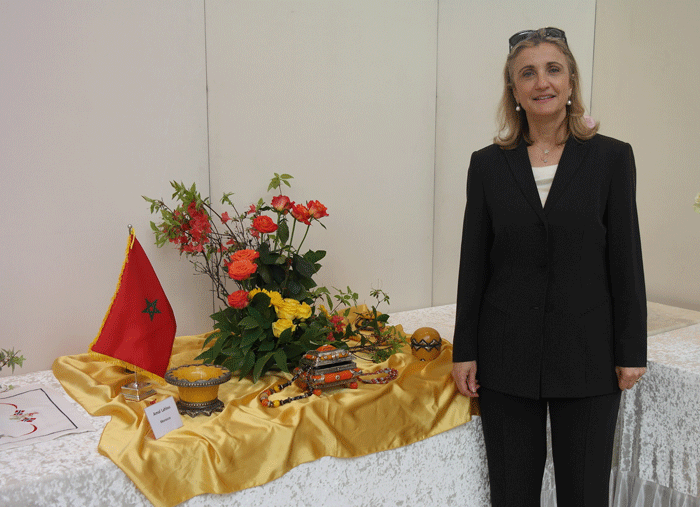
Excerpts from the details on Scholar-Philosopher Hong Ja-seong (from Wikipedia):
Chinese Caigentan combines cai 菜 "vegetables; greens; (non-staple) food; dish; course (in menu)", gen 根 "roots (of plants); bottom (of mountains)", and 譚 "talk; conversation; discourse". This compound caigen 菜根 "inedible root of a vegetable; cabbage stalk" is a literary metaphor meaning "bare subsistence" (originating in Zhu Xi's Xiaoxue 小學 "Minor Learning"). The Chinese proverb Jiao de caigen, baishi ke zuo 嚼得菜根, 百事可做 literally means "[One who has] chewed vegetable roots [for lack of anything better to eat] can accomplish anything", or figuratively "One who has gone through hardships can do anything". "By vegetable roots, food such as turnips, radish, carrots and sweet potatoes is meant", says Vos.
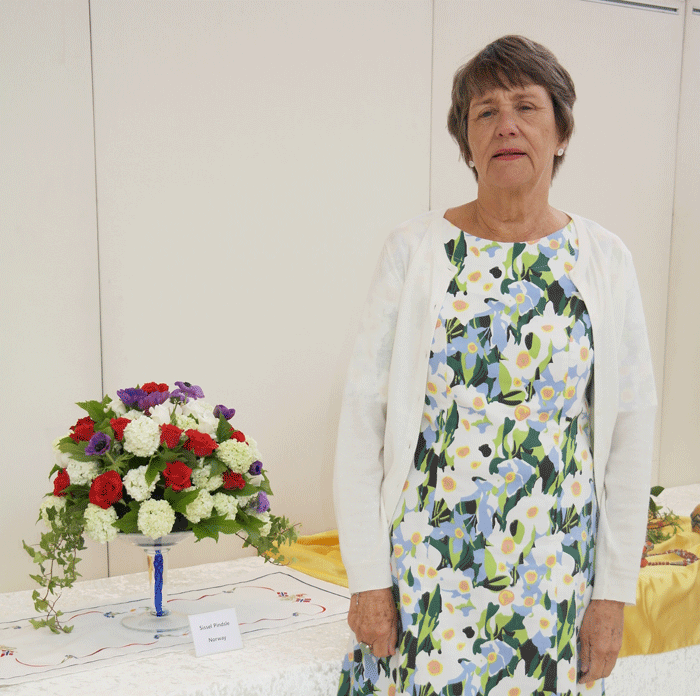
The history of Caigentan editions is convoluted. No original text is extant in China, and the earliest printed editions are preserved in Japan.
Traditionally, the two received Caigentan versions are identified by whether they list the author Hong's given name Yingming 應明 or courtesy name Zicheng 自誠. These two texts have three early prefaces. The first "Zicheng version" preface is by Yu Kongjian 于孔兼, a contemporary friend who calls the author Hong Zicheng. The second and third "Yingming version" prefaces, dated 1768 and 1794, are by Suichutang zhuren 遂初堂主人 "Suichu Hall Master" and Sanshan bingfu Tongli 三山病夫通理 "Three Mountains Invalid Tongli".

The classic Caigentan "Vegetable Roots Discourse" remains popular in the present day. Digital editions are freely available on the Internet, and comic book adaptations are offered in both Japanese manga and Chinese manhua.
In terms of traditional Chinese literary genres, the Caigentan is a yulu 語錄 (lit. "recorded sayings") "quotations; aphorisms", a subtype of shanshu 善書 ("good book") "moral-instruction; morality" book category.
The individual entries are predominantly written in pianwen ?文 "parallel style", an ornate rhythmical prose marked by parallelism or chiasmus. For instance,
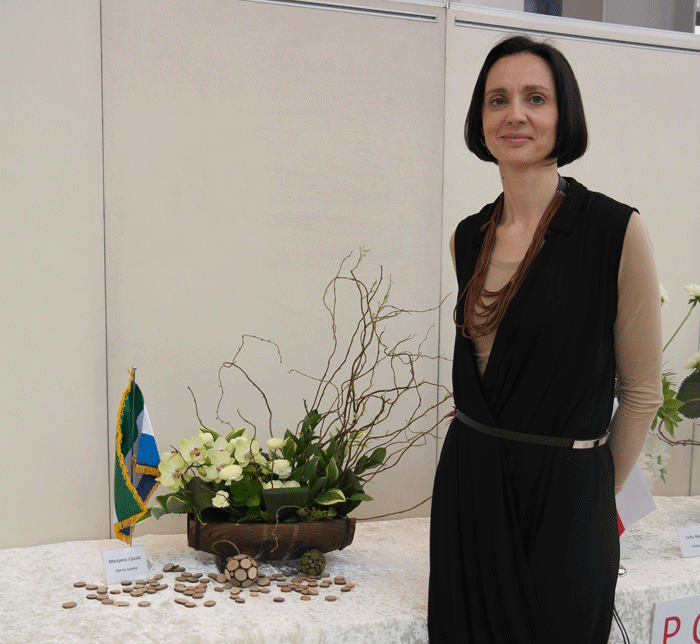
口乃心之門, 守口不密, 洩盡?機; 意乃心之足, 防意不嚴, 走盡邪蹊. The mouth is the portal of the mind. If not carefully guarded, it leaks true intents and motives. Feelings are the feet of the mind. If not carefully watched, they will take you onto all kinds of wayward paths.
The Caigentan records life lessons from the decadent and corrupt late Ming society, many of which have universal appeal. Take, for example, this warning to partygoers.
Those who pick up their coats to depart at the height of festivity are admired as adepts who can halt at the precipice. Those who pursue their night journey after their candle has burned out are ridiculed as ordinary persons awash in the bitter sea.
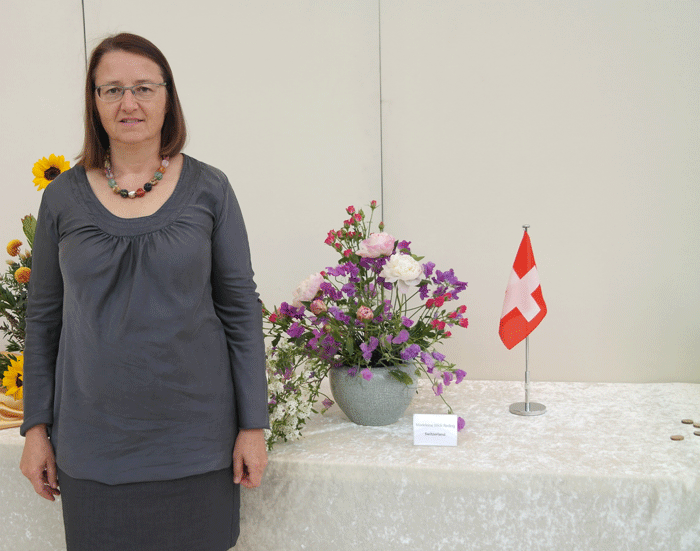
Referring to the first of the Buddhist Four Noble Truths, Sanskrit dukkha (Chinese ku) "suffering; bitterness", this kuhai 苦海 "bitter sea" is the Chinese translation of dukkha-samudra "sea of bitterness; ocean of suffering".
Retirement and old age are common themes in the Caigentan.
The sun is setting and the evening clouds are more colorful than ever. The year is about to end and the oranges and tangerines are all the more fragrant. Thus noble persons in their old age should all the more enliven their spirits a hundredfold.
There is an ancient vessel which is so constructed that when it contains no water, it stands obliquely; when half filled, it stands upright; but when full, it will fall down. There is another antique vessel made of earth and used as a savings-box. It has a small opening, through which coins are dropped. Thus, the former falls when it is full, while the latter is useful because it is empty within. Such is the way of the supreme man. He prefers nothing to something; he is content with want rather than seeking after fullness.

When the water bottle is full, it overturns. When the piggy bank remains empty, it is whole. Therefore, the gentleman: Resides in vacuity rather than existence, and exists in the lacking rather than the complete.
There is a kind of vessel that tips over when it is full. A piggy bank is not broken as long as it is empty. So for enlightened people it is better to dwell in nonbeing than in being, better to be lacking than replete.
The qi vessel tips over when it is filled with water. The puman money stays whole so long as it is not filled up with money. Therefore, the accomplished man prefers to settle in a place where there is neither strife nor striving, and dwell in an incomplete placed, not a finished one.
A vessel topples because it is too full. A piggy bank is saved from being shattered for its emptiness. So a true person prefers "have-not" than "have". Rather be incomplete than to be complete.
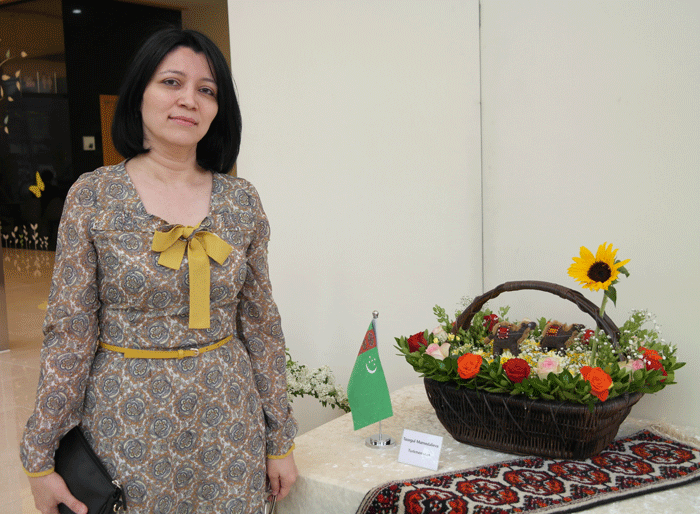
The qiqi water vessel tips over when it is full. The puman money-saving vessel is perfect when it is empty. The noble person abides with nothing rather than with something, and is content with lack rather than with completeness.


